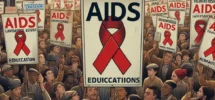Imagine a storm brewing silently in the distance—unseen, unheard—until it suddenly crashes upon the shores of society with devastating impact. That’s how AIDS arrived in the United States. While its roots trace far beyond American borders, the epidemic’s dramatic emergence in North America during the early 1980s changed the face of public health forever and sparked global concern around the haunting question: Where did AIDS come from?

The First Alarms: A Mysterious Illness
In June 1981, the U.S. Centers for Disease Control and Prevention (CDC) published a quiet report in its Morbidity and Mortality Weekly Report describing five previously healthy young men in Los Angeles diagnosed with a rare pneumonia (Pneumocystis carinii). All five were gay, and two had already died. Doctors were puzzled. These men exhibited symptoms of severe immune suppression—but why?
This marked the official beginning of the AIDS epidemic in the United States.
Within months, similar reports began emerging from New York, San Francisco, and other major cities. Kaposi’s sarcoma, a rare cancer, began appearing among young men. Hospital wards started filling with patients wasting away from infections no healthy person should contract. The question echoed louder: Where did AIDS come from, and why was it targeting specific communities?
The Early Misunderstandings
The early 1980s were shrouded in confusion and fear. Initially termed GRID—“Gay-Related Immune Deficiency”—the condition was unfairly linked solely to homosexual men. This stigmatization slowed public response and isolated those suffering. Soon, however, AIDS was found among hemophiliacs, intravenous drug users, and even infants born to infected mothers. The scope was broader, and deadlier.
This widening lens forced scientists to look beyond American shores to understand the origins of the virus and to answer with science the lingering question: Where did AIDS come from?

Tracing the Roots: Africa to America
By 1983, scientists had identified the virus that causes AIDS: the Human Immunodeficiency Virus (HIV). But the origin story went even deeper.
Researchers traced HIV to a related virus called SIV (Simian Immunodeficiency Virus) found in chimpanzees in Central Africa. Genetic analysis showed that sometime in the early 20th century, SIV jumped from chimpanzees to humans—likely through the bushmeat trade—mutating into HIV. This zoonotic leap marked the beginning of HIV’s slow journey across borders.
The virus spread silently for decades in Africa before making its way to Haiti in the 1960s and later to the United States in the 1970s. By the time it was noticed in the 1980s, HIV had already taken root in the population. Thus, when asking “Where did AIDS come from?”—the answer spans continents, decades, and species.
The 1980s: Awareness and Advocacy
As death tolls mounted, activism surged. Organizations like ACT UP and GMHC (Gay Men’s Health Crisis) emerged to demand treatment, research, and compassion. Celebrities like Rock Hudson and later Magic Johnson brought the disease into the public eye. The U.S. government’s sluggish response was criticized, especially under the Reagan administration, which failed to address the crisis adequately in its early years.
AIDS was no longer just a health issue—it was political, social, and deeply personal.
Legacy and Lessons
Today, AIDS in the USA is no longer the death sentence it once was. But the scars of the early epidemic remain.
The journey of AIDS in the USA reveals both the fragility and resilience of society when confronted with an invisible enemy. And at every point, the recurring question—Where did AIDS come from—drives home the importance of understanding origins to prevent future pandemics.
The history of AIDS in America is more than a timeline of events—it’s a mirror reflecting human behavior, prejudice, scientific discovery, and the relentless search for answers. By unraveling where AIDS came from, we not only expose the roots of one of history’s most lethal epidemics but also gain insight into how to protect future generations from similar crises.
In this story, the keyword isn’t just a search term—it’s a question that shaped decades of lives, policies, and progress: Where did AIDS come from?


